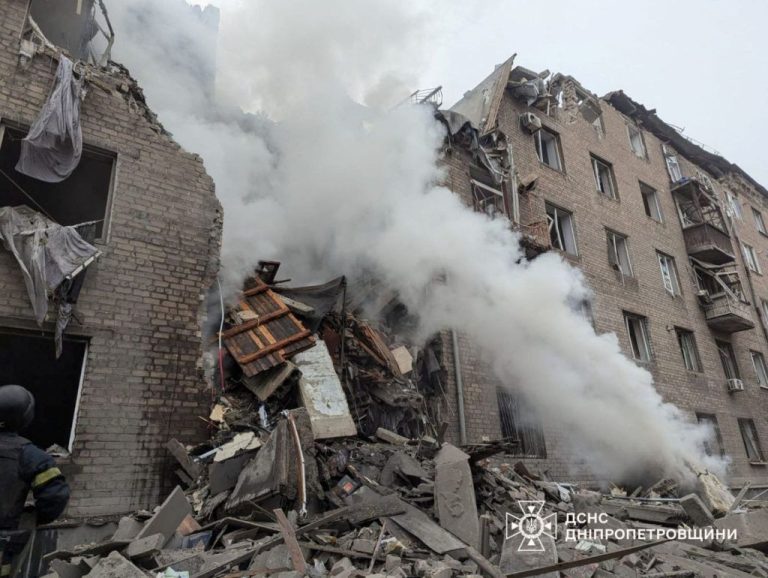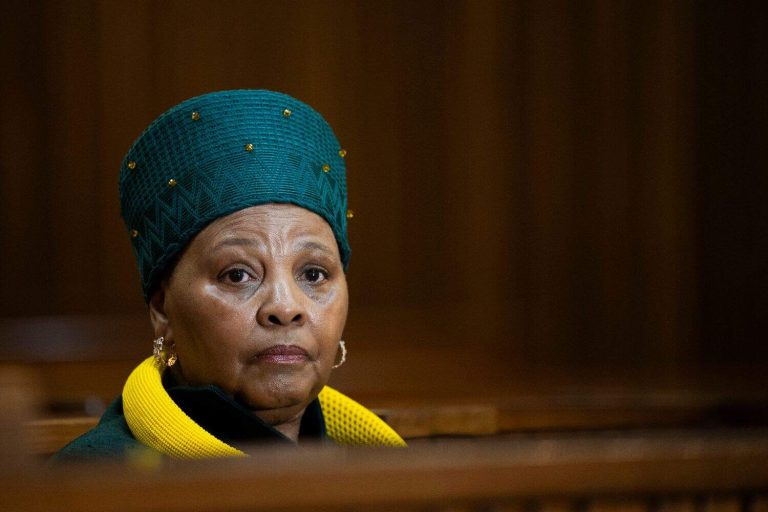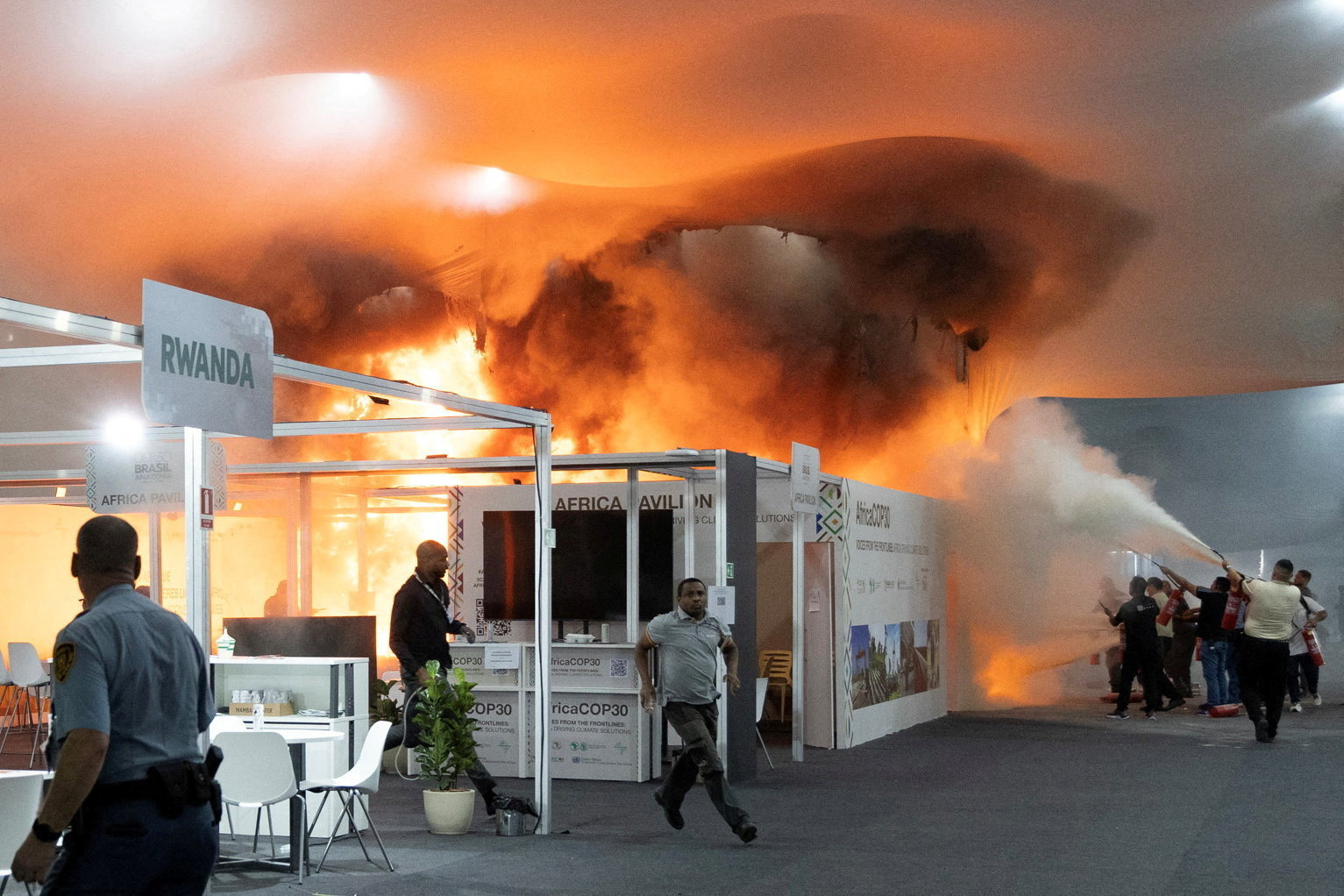
People use fire extinguishers to put out a fire at the Pavilion of Countries in the Blue Zone at the United Nations Climate Change Conference (COP30) in Belem, Brazil, November 20, 2025. REUTERS/Douglas Pingituro TPX IMAGES OF THE DAY
Details of the extent of the physical and schedules damage caused by a fire that broke out at a section of the venue of the COP30 global summit on climate change emerged earlier this morning.
The fire broke out shortly after 2pm local time, halting negotiations, scattering delegates across the venue, and plunging the UN climate conference into logistical disarray during its critical penultimate stage.
Thick smoke rose swiftly above the affected section of the conference area, prompting venue-wide alarms and an immediate evacuation.
Conference participants scampered in confusion as they were directed toward emergency exits under the supervision of UN security teams and Brazilian authorities.
The fire, though contained rapidly, cast a long shadow over a summit already wrestling with slow progress on adaptation finance, fossil fuel phase-out language, and the Global Stocktake.
People evacuated, some treated on site
In its first statement, released later in the afternoon, the UNFCCC said, “Earlier today, a fire broke out in the Blue Zone of the COP30 venue in Belém. The fire department and UN security officers responded swiftly, and the fire was controlled in approximately six minutes.
People were evacuated safely. Thirteen individuals were treated on site for smoke inhalation. Their condition is being monitored, and appropriate medical support has been provided.”
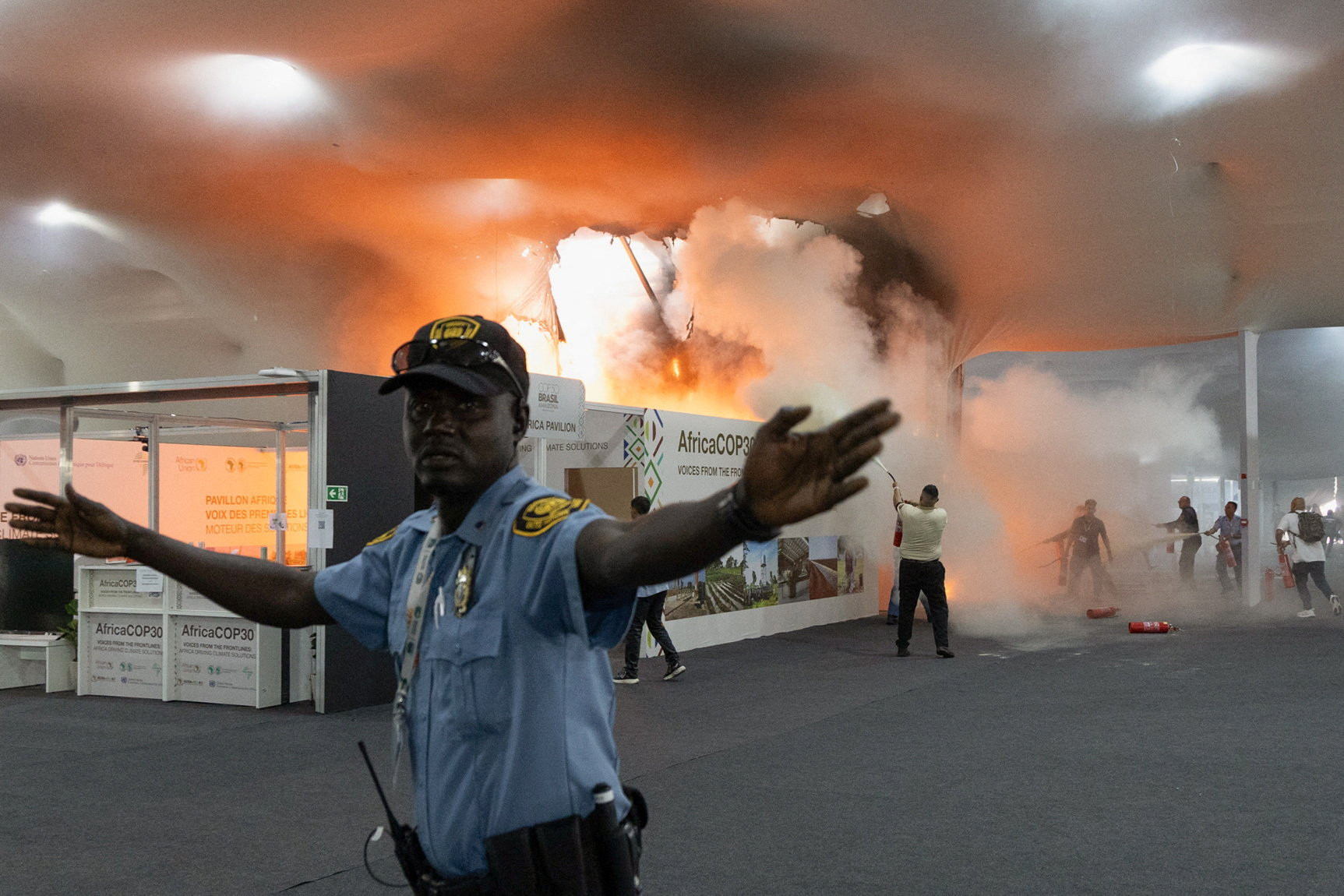
The statement continued that, as a precaution, the Brazilian Government and the UNFCCC had jointly decided to temporarily close the Blue Zone as the fire department carried out a comprehensive safety assessment.
Once the smoke lifted late in the afternoon, the extent of the physical destruction became clearer. A narrow corridor between the East African Community pavilion and the Africa pavilion was in ruins.
Darkened pillars stood exposed where pavilion walls had once displayed national colours, maps, and cultural installations. The cloth-lined walls and roofing, which are common features of the temporary COP structures here, were completely incinerated.
Metal frames lay twisted, furniture reduced to ash, and electrical fittings melted into contorted shapes. The area remained sealed off through the evening as emergency teams stabilised the site.
Mr Kudakwashe Manjonjo, a Zimbabwean who was a panellist at an event at the Africa pavillion when the fire broke out, said the blaze appeared to have started in the space between the East African Community and Africa pavilions.
“Because the pavilions were lined with cloth on the walls and roof, the flames moved incredibly fast. One moment it was a small flare, and the next, everything was burning,” said Mr Manjonjo.
Cause of fire
A source who attended a COP Bureau meeting later in the evening told the Nation on condition of anonymity that initial investigations suggested the fire had been caused by an electrical overload in the Africa pavilion, noting that the assessment had concluded that there had been “no structural fault” of the electrical wiring.
The fire caused the cancellation or delay of multiple high-level events scheduled for the afternoon.
These included a ministerial roundtable on adaptation ambition, a technical dialogue on the Global Stocktake outcomes, mitigation work programme consultations, and several engagements involving youth groups, Indigenous Peoples’ organisations, and civil society networks.
Side events, pavilion sessions, and bilateral meetings across the Blue Zone were also suspended.
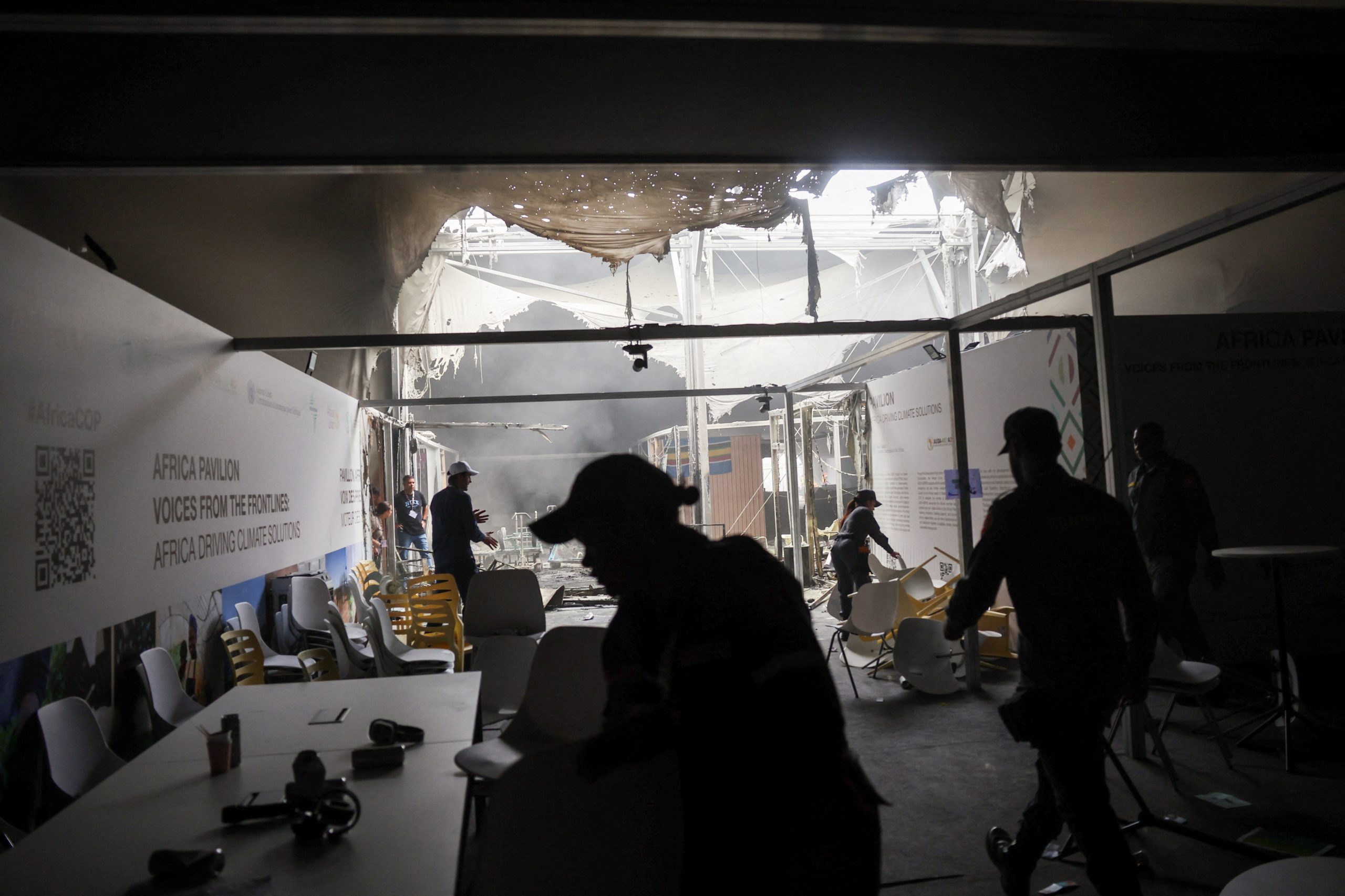
The cancellations rippled across the remainder of the day, forcing negotiators to postpone key text discussions at a point when COP30 was already struggling to accelerate progress towards draft decisions.
Delegates from several regions described the disruption as deeply unwelcome and badly timed, coming just 48 hours before the summit’s expected close.
Across the wider venue, schedules that had been packed with meetings were abruptly emptied, leaving negotiators to wait for confirmation on when work would resume.
Later in the night, the COP Presidency issued a second, more definitive statement, advising that the Blue Zone had been reinstated and had resumed operations at 8:40pm.
“Following a safety assessment, we inform you that the site has been inspected and deemed safe by the Fire Department. Brazilian authorities have restored operating conditions at the conference venue, obtained the Fire Department’s operating permit, and returned the area to the UNFCCC,” it said.
The Presidency clarified that the damaged section would remain cordoned off, with structural and electrical teams continuing assessments, and that it was closely monitoring the condition of all individuals who required medical attention.
“There will be no plenary activity this evening,” it concluded.
Political tension
The fire struck at a moment of mounting political tension at COP30, where key divides remain on climate finance, fossil fuel phase-out language, and measures strengthening global adaptation support.
With the conference poised to enter its final hours, negotiators now face a compressed timetable that will add intensity to Friday’s deliberations.
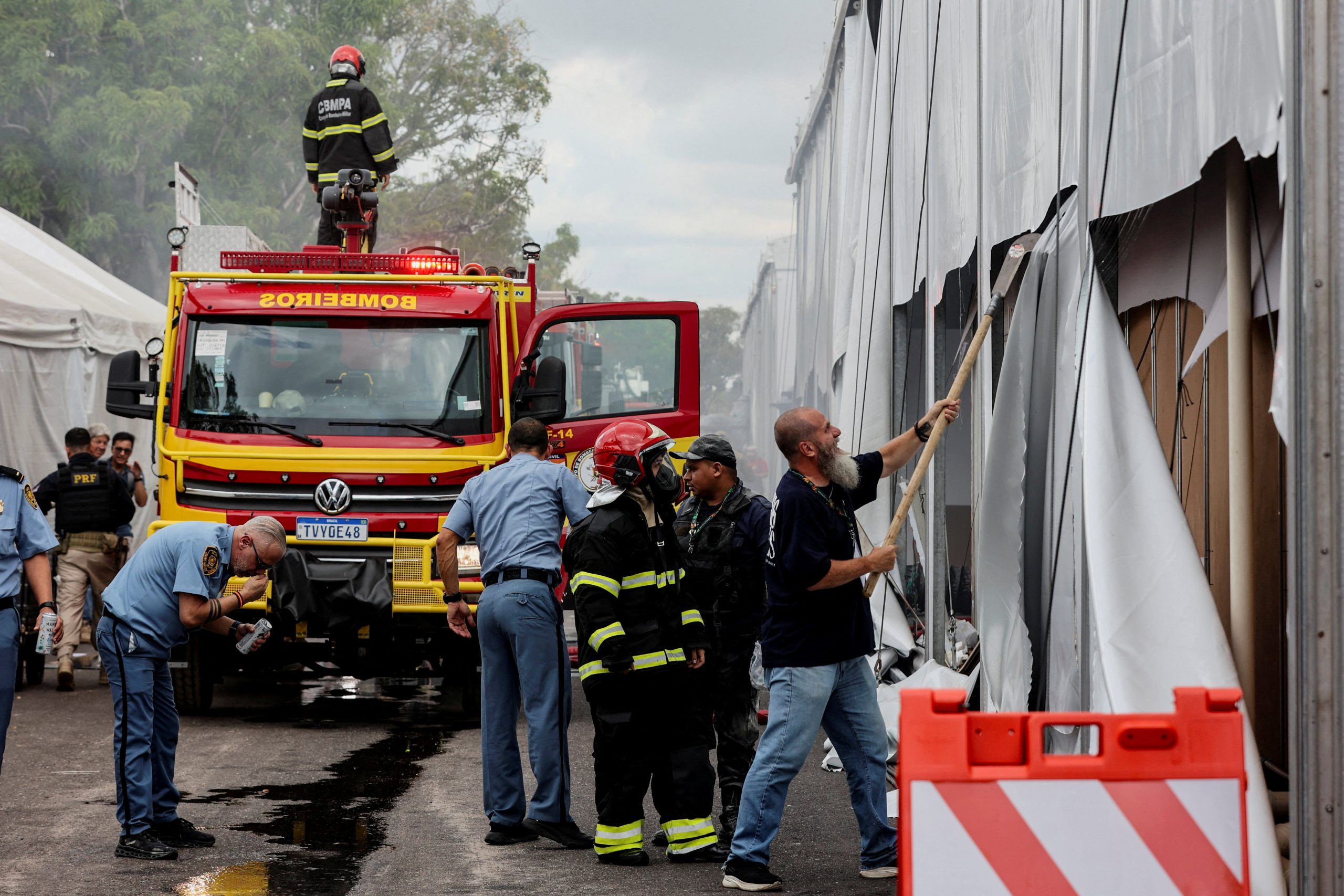
The incident has also drawn attention to the vulnerability of temporary structures that dominate COP host sites and the concentrated presence of national and regional pavilions built from flammable materials.
While Brazilian authorities are expected to review the fire’s technical origins in greater detail, early indications of electrical overload have already triggered calls from some delegations for more rigorous safety requirements for future summits.
By midnight, the venue had largely regained its operational rhythm, although the emotional impact lingered. Delegates described a mixture of relief and apprehension.
Relief that the incident caused no severe injuries, and apprehension that the lost hours could heighten pressure in already difficult negotiations.
This morning the razed pavilion area, left in stark contrast to the rest of the brightly lit conference site, stood as a sombre reminder of the day’s upheaval. And now, with COP30 entering its final stretch, all eyes now turn to whether negotiators can regain momentum and deliver the political breakthroughs that had originally been planned for Thursday.


